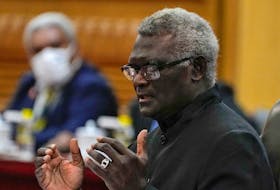More agricultural scientists, refurbished labs and multi-million dollar equipment were part of an announcement in Harrington on Wednesday to boost the farming sector in P.E.I.
Federal Agriculture and Agri-Food Minister Lawrence MacAulay joined newly hired researchers at Agriculture and Agri-Food Canada’s Harrington Research Farm to announce the completion of a $6.8-million upgrade of the facility.
The upgrades include $2.97 million for 10 new and renovated laboratories and the purchase of a $1.3-million nuclear magnetic resonance spectrometer for the Charlottetown Research and Development Centre on University Avenue. It also includes $2.54 million for an expansion of the Harrington Research Farm greenhouse.
The spectrometer allows scientists to study farm soil at the molecular level, which will help farmers improve the soil health and productivity of their land.
Three of the five scientists hired by the research centre hired over the past 18 months occupy new positions that expand the facility’s areas of research. The five specialists are a microbial ecologist, an agro-ecosystem modeler and date scientist, a weed specialist, an environmental chemist and a cereals and oilseeds biologist.
Fast facts
- The Charlottetown Research and Development Centre was established on Aug. 14, 1909 as Canada’s ninth federal agriculture research facility
- It currently has a staff of 80 people
- In addition to the new nuclear magnetic resonance spectrometer for soil research announced Wednesday, the centre also has a second spectrometer dedicated to research to identify plant molecules with potential to improving human and animal health
- The growing space in the centre’s greenhouse in Harrington has been doubled to 392 square meters
Mark Grimmett, associate director of the Charlottetown Research and Development Centre, said the investment will allow the centre to double its greenhouse capacity in Harrington.
“You can get two growing seasons in one year . . . so you can get twice as much work done in one year as opposed to waiting for next spring to start the next crop and the next round of breeding so that can accelerate your development of new lines for breeding material,’’ Grimmett told The Guardian.
“For Island farmers it’s accelerating their rate of information that we can discern from an experiment. Twice as much growing season. We can simulate conditions in a field multiple times through the year and look at the factors that cause diseases to form in their crops or insects to prosper in their crops and ways to counteract that.’’
David Mol, president of the P.E.I. Federation of Agriculture, said the fact that Island farmers will get access to information a lot quicker cannot be understated.
“That’s probably the key thing is just moving things ahead in the timeline,’’ Mol said.
MacAulay said it’s about helping Island and Canadian farmers compete on the international market because research like this is happening all over the world.
“More scientists means more research (and) more innovation means better results for the farming community, not only in Prince Edward Island but right across the country,’’ the minister said.
MacAulay added that as a former potato farmer he finds it interesting to see the centre has recreated conditions for late blight or developing traps for wildworms and dealing with insects in a more environmentally friendly way.
“We could have used a lot of this (information) when I was a farmer,’’ MacAulay said.








